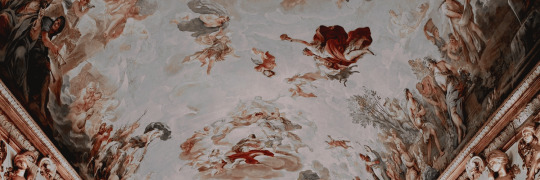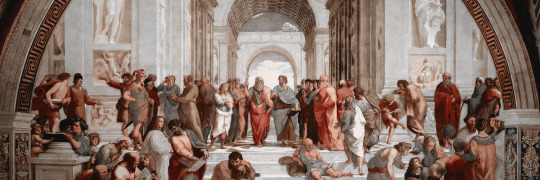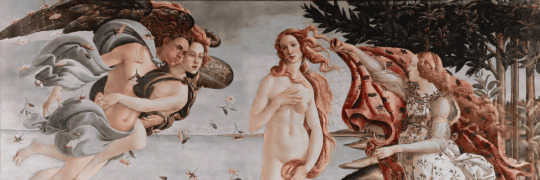Quote
Material conditions that people live in shape their characters and individual destinies
Mike Vanden Heuvel
14 notes
·
View notes
Photo
In the Renaissance era, humans were revered to a greater extent than ever before. This was a time for idealizing the human form through new artistic methods. Artists such as Leonardo da Vinci, Michelangelo, Georgio Vasari, etc. made use of geometry, chiaroscuro, and color in order to further highlight the Renaissance’s growing focus on human value. In their works, the artists were able to establish definitive associations between the literal depiction of the divine realm and the human subjects of the painting. This sort of mirroring effect creates the idea that the two realms are intrinsically similar, or even the same in the appreciation they deserve. However, realism took a different approach to human value. Biblical figures were no longer captured within art and scenes came to depict the reality of life rather than glorifying humankind. In realist art, humans were no longer seen in such high regard and artists began highlighting the struggle and hardship of the Industrial Revolution.





17K notes
·
View notes
Text
Industrial Revolution & Proletariat
The Industrial Revolution fueled expansion and development in 19th century. The result of massive corporate infrastructure was a rise in the proletariat: a class of workers who neither owned the means of production nor the control of their own work. These workers gave up their own labor in exchange for wages because this is truly all these people had to offer. The proletariat was a dominant, massive class within society whose members struggled to survive on a daily basis. These people had minimal economic and political power during 19th century. However, these lower, working class citizens had the potential to turn on industrial creators (the middle class) in order to destroy them once they realize their power and find their voice. This class is truly the product of industry, science, and technology and constantly created anxiety amongst the middle class. They could rise up at any moment, like a foreshadow of new monstrous power (Frankenstein) on the horizon. These people were largely uneducated, defined solely by brute strength and force, and constantly had class tension rising. Realist artists depicted the proletariat in the majority of their works, highlighting the struggle of physical labor and the hardship of those experiencing the direct impact of the industrial revolution.
0 notes
Photo


https://drive.google.com/file/d/1COKbUZjy_bYvvg2qPgngUVFo0gghxi-7/view?usp=drives
0 notes
Photo


Paris, at this time, was the epicenter for art and early modernism. The population rapidly increased with a constant feeling of unrest. Napoleon III decided to give the city a face lift and completely urbanized the entire landscape. In this expansion, he incorporated many suburban cities into Paris and made railroads for advancements in travel. Due to these technologies, many were able to travel from rural areas to the city for work, and these agrarian scenes tend to be the subject for many realist artwork. For example, Jean-François Millet’s “The Gleaners” which is being captured above.
0 notes
Photo
Courbet was at the forefront of the Realism movement. He was inspired by genre paintings and scenes of everyday, ordinary life. His work was intended to make people aware of the plights of the poor, laboring class citizens.
Pictured: Gustave Courbet’s “The Desperate Man”

171 notes
·
View notes
Photo

A Burial At Ornans, Gustave Courbet
https://drive.google.com/file/d/1ZRmtnk3Yk6NNr5pDaqN9HC-O_LRZCUtt/view?usp=drivesdk
0 notes
Photo
The subject for the majority of realistic works was something from everyday life. There was no history involved in this new movement; biblical scenes and past wars were rarely depicted during this time. The main rule for Realism was that the subject matter must be contemporary. Therefore, the figures could be workers, laborers, prostitutes, religious ceremonies or persecutions, burials, death, or anything else that happens in daily life.

Fresh Eggs, 1874, Winslow Homer
Medium: watercolor,paper
18 notes
·
View notes
Photo
Most artists within the Realism movement made a special effort to make their paintings unideal. They used ugly, dark colors, awkward compositions, grotesque figures, and applied paint to the canvas in irrational ways. The grittiness of these works relays the social message about the recognition of the poor and their immense suffering. Often times it seems as though the artist was right in front of the scene, almost as though they are sketching the scene but with paint.

A Drowned Woman (Found Drowned), 1867, Vasily Perov
Medium: oil,canvas
194 notes
·
View notes
Photo
Most realistic art conveyed images of poverty and peasants. In this piece, we see two laborers making jam with only their hands as means of production. While many artists use a dark palette for their realistic work, some chose to use brighter colors that are less grotesque. Although vibrant, the image still gives a sense of pain and hardship. This lighting establishes a sense of power within the piece because of the genuine struggle and labor stricken figures that are being highlighted within the scene.

Making Jam, 1876, Vladimir Makovsky
Medium: oil,canvas
174 notes
·
View notes
Photo
In this piece, Courbet has chosen to use a brighter color palette. With a use a of light colors, Courbet is still able to convey the agonizing pain and work these people endured. All three workers are sitting down and focused on the task at hand. Similar to many realist pieces, the characters appear to be anonymous. This allows the viewer to focus on the hardship and the distorted form of the figures, rather than the individuals themselves. Rather than a highly educated, autonomous workforce that provided value to society, most upper class citizens felt as though the proletariat was simply a group that supplied labor to support the rest of functional society.

The Wheat Sifters, 1855, Gustave Courbet
Medium: oil,canvas
28 notes
·
View notes
Photo
Artists began to experiment with composition and content as the movement progressed. Artists bent over backwards just to make uncomfortable arrangements of figures and scenes, but still posed and configured in realistic manner.

The Luncheon on the Grass - Édouard Manet
28 notes
·
View notes
Photo
Whistler is an artist who began creatively making art for art’s sake. He chose to make his composition based upon color harmonies as he and other artists continued to experiment with the content and construction of their pieces. These artists continuously rebelled against educational paintings that the academy so desperately wanted in order to create real, aesthetically pleasing works.

James Abbott McNeill Whistler
Nocturne: Blue and Gold - Old Battersea Bridge
Oil on canvas, c.1872-5
Tate Gallery, London
55 notes
·
View notes
Photo
This is an example of art for art sake and a perfect depiction of composition off color harmonies. The artists has used a variety of monochrome colors to highlight the labor intensive life and routine of a lower class kitchen maid.

A Kitchen Maid, 1919, Anders Zorn
Medium: oil,canvas
273 notes
·
View notes
Photo
Realistic art tended to have mixed reviews. Some people loved it and some people hated it. The main criticisms people had were based upon size, content, and even how the piece was painted. Many felt that these genre paintings were on too large of canvases. Large canvases were only meant for revered, academy-approved paintings and these pieces were not considered at such an elite status. Many felt the color was too dark and conveyed a bad message about life experiences. Upper class citizens also felt uncomfortable with the proletariat subjects of these art. These works were controversial because of their overall message and subject figures. Everyone seemed to have an opinion; whether it be positive or negative depended heavily on status.

Olympia, 1863, Edouard Manet
Medium: oil,canvas
143 notes
·
View notes